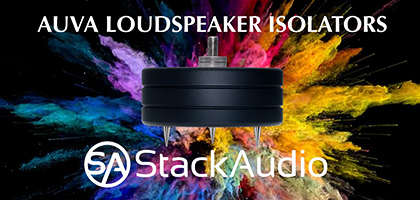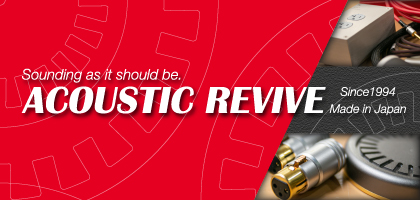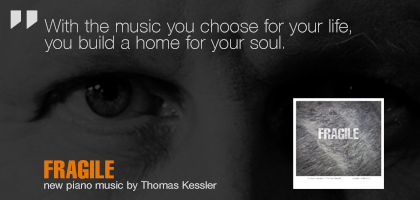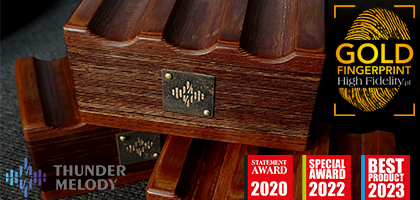No. 258 November 2025
- COVER REVIEW: BLADELIUS Oden II Class-A ⸜ integrated amplifier » SWEDEN
- INTERVIEW: "The Editors" series № 37: ANDREW SIMPSONS • Audiograde ⸜ editor-in-chief » UNITED KINGDOM
- TECHNIQUE: digital recorders: DENON PCM part 2 - DN-23R tape recorder || 1972-1974 » JAPAN
- REVIEW: ACOUSTIC REVIVE RTP-4EU Final ⸜ AC power strip » JAPAN
- REVIEW: AUDIO REVEAL Classic ⸜ integrated amplifier » POLAND
- REVIEW: FOUND SOUND DAVIO Davio Azure ⸜ digital-to-analogue converter » POLAND
- REVIEW: LAIV Harmony GaNM ⸜ power amplifier • monoblocks » SINGAPORE
- MUSIC ⸜ Our albums series: ASTOR PIAZZOLA AND HIS TANGO QUINTET, Live in Lugano 1983, Ermitage/AudioNautes Recordings, Ultimate HiQualityCD


|

|
|
MAY YOU LIVE IN INTERESTING TIMES! 
But sometimes a miracle happens and while listening to the recording we actually manage to forget about mechanical character of its reproduction. We listen to the music all our lives and almost everywhere – when we sit in front of a computer, when we drive a car, watch TV, listen to the radio and this way we 'learn' how the music 'should sound like', meaning how it sounds reproduced by different devices instead of learning how it sounds played live. These two sounds are completely different, but they do have one thing in common – they are able to ignite similar emotions. And that's what music is really about – it's transfer of emotions, from composer, musicians and music itself to the listener. Some audiophiles have to cope with a 'self-inflicted' illusion, a believe that using a recording and devices for its reproduction, which in fact means converting electrical signals into acoustic ones, will grant them a similar experience to that of a live performance. I, fortunately, don't believe that. But I do cope with a problem, shared with many audiophiles, of a different nature – I believe that it is possible to extract so much information from music, that it could suppress a skeptic in me, turn of my analytical nature and turn on the “experiencing, living it” mode. 
To achieve that one needs an audio system. The more experienced listener the higher quality (hence the more expensive – quite an important part of the problem) system is needed. Although I have to admit that it happens sometimes that I get totally immersed in music played by a shoe-box-size radio. But it is definitely easier to achieve when I can hear same sound as musicians playing it. But to experience something like that we need proper quality recording or on rare occasions a transmission from a live event. Today one may choose his favorite music medium among many available ones: streaming, music files, CD, SACD, BD Audio, vinyl, cassette tapes, reel-to-reel tapes – there are multiple choices available. If you really, rally want to you could even pick cylinder records currently offered by American company Vulcan Records. DIGITAL MEDIUM One of the ways to make source/master material that are in labels' possession available to the customers is to transfer it onto digital medium. New, more advanced means to do so have been developed. As a result a wide range of formats emerged as every company had its own idea about it. Next generations of customers present their own attitude towards different formats and its them who decide about which formats are widely accepted and which are not. More often then not their choice has nothing to do with sound quality. The more important the ideas/solutions that are intended to improve sound quality become. Today most of them are developed for music files playback. Computer industry has rapid development in their DNA, and quickly changing requirements of ever bigger, ever faster growing market play their role too. Lots of good came from the recent 'vinyl revolution', because even though the industry still uses the same old press machines, record-cutting machines the whole process itself has been improved. I guess that you realize that in 1970ties and 1980ties most records were scraped either because of poor material or poor pressing quality. Today most records are pressed on a 180g 'virgin vinyl' or otherwise they don't stand a chance of success. 
But also Compact Disc and Super Audio CD formats are constantly improved. For me, a CD fan, it's is very important. But even if you don't share my enthusiasm for the format you should follow information on all novelties related to it because many of them sooner or later will effect also other formats – music files and even vinyl. STOCKFISCH RECORDS I also discussed already many times methods used by Stockfisch label, intended to allow their recording to sound more similar to live music, and on the other hand to improve a playback process. There are three people responsible for the sound of Stockfisch Records releases: Hans-Jörg Maucksch is responsible for recording and mastering phase, Inés Breuer assists the producer, and recordings are executed usually in Pauler Acoustics, run by Hendrik Pauler. I believe that they already explored all possible combinations of recording and mastering methods including: fully analogue process, 24-bit PCM files, then DSD, CD and hybrid SACD, and finally vinyl records pressed from analogue material, PCM one and DSD one. As I understand the DSD option prevailed: studio prefers SACD releases with DSD signal recorded and mastered in this domain. The CD layer on hybrid SACD albums is prepared using a process called SBM Direct. Nobody confirms that officially but the CD layer utilizes the Super Bit Mapping, a noise shaping process, developed by Sony that converts a 20-bit signal from master recording into 16-bit signal nearly without sound quality loss. 
Also Stockfisch vinyl records are pressed using digital files – PCM and DSD. Unlike 99% of other records these are not cut on a soft acetate material but rather on a copper plate using DMM - Direct Metal Master technology. Developed by TelDec (Telefunken-Decca) and Georg Neumann GmbH to help to stop customers' exodus from LP towards CD format. In short the cutting lathe engraves the audio signal groove directly into a copper-plated master disc, instead of a lacquer-plated aluminum disc. The DMM copper master disc can be plated to produce the required number of stampers using the one-step plating process. Rather than having to electroform a master (or "father"), mother and then stampers (the traditional "three-step process"), the DMM copper disc serves as the 'mother". Bypassing the silvering process and two electroforming stages reduces the risk of introducing noise that can be generated in the electroforming (galvanic) process. In cases where hundreds of stampers may be required, the DMM disc is often plated to produce a master and mother, from which many stampers are then made. Stockfisch has been using this technology for years using an ultra-soft copper that was unavailable in the past. As I mentioned when reviewing David Roth's album Will You Come Home, initially fans complained about unnaturally harsh sound created using this process. And they were right about it. But the label believes that they managed to overcome this issue by, among other things, using a super-soft copper. One of the requirements that allow to prepare a proper master is delaying one channel by exactly 0,909 s. Stockfisch solved this issue delaying the signal in digital domain while cutting copper plate. DMM-CD/SACD In theory transferring a digital recording on vinyl degrades sound quality. From technical perspective vinyl record, and in general the whole analogue technology, is full of distortions and errors. But a listening test proves that this claim isn't true, that people who claim that most likely do not know what to measure, what is really important for musical experience. Guys from Stockfisch found out that material recorded as a DSD or 24-bit PCM file, when transferred on vinyl record, especially a 45 r.p.m. one sounds differently, according to them - better. It's a paradox, not the first and not the last one in audio. What's important here is the this conclusion was not reached by some crazy audiophiles, that nobody takes seriously, but professionals, down-to-earth people who always try to get to their goal using shortest possible way, because time is money. So when in 2014 they presented a sampler, The Stockfisch DMM-CD/SACD, Vol. 1 they did it because they felt the need to do it driven by their pursue of delivering the highest quality sound. |
I wrote about this sampler in a coverage of the 90th Krakow Sonic Society meeting, but only about the sound and not about the way it was prepared. And it was quite unique, different that what most audiophile believe is the best option best expressed by statement: “the simpler the better”. This technology was called DMM-CD/SACD. The name tells us that this is a hybrid SACD mastered using DMM technology. 
Process starts with cutting DMM disc from digital files (an analogue signal could also be used). Disc is cut at 45 r.p.m. speed, using only this part of disc's surface with zero degree tracking error. This means that material for a single SACD album has to be cut onto few such masters. Next signal is read from master using EMT TSD-15 (a special version of legendary Broadcast TONDOSE TSD-15 cartridge) mounted on EMT 997 tonearm. In this particular case the Neumann VMS-82 cutting machine acts also as a “turntable”. Signal from cartridge is sent to the tube phonostage, EMT JPA66. A Neumann correction curve that cuts off the signal below 20 Hz is applied. Then analogue signal from phonostage is sent to Meitner EMM Labs adc 8 MK IV A/D Converter. It is a reference device that converts signal to a 1-bit Direct Stream Digital format. A DSD signal of 2,8224 MHz sampling frequency is then recorded using SADiE DSD8 mastering system. Exactly the same signal can be found on SACD release. A simplified version of the process looks like that: DOUBTS There are some doubts concerning this process. First of all signal is converted twice between domains – first from digital to analogue and later from analogue back to digital. What's more: signal is cut to the disc using lathe cutter and then the signal must be read by stylus, so a linear signal must be converted using RIAA correction curve, and then the process has to be reversed. This process purposely introduces distortion to the signal. Not only that but these are also distortions of different types intended to make SACD and CD sound more like analogue medium. In late 1990ties Bob Carver had a similar idea in regard of RIAA curve. He assumed that it introduced positive changes to the sound. He build the Sunfire Classic Vacuum Tube Control Center but the product did not succeed at the time. Stockfisch used this idea additionally introducing a double conversion to the process. The first volume of the DMM-CD/SACD sampler offered an interesting performance, but in my opinion the sound was bit too harsh. Also when listening to it I heard some pops. So for me it was rather a curiosity and not a new promising way to improve sound quality of CD and SACD mediums. In Chine some more albums using this technology were released, and on February the 19th 2016 the Volume 2 of this sampler was released. 
It is much more elaborate than the Vol. 1. There is a very nice 60 page booklet with pictures and step by step description of the whole process and equipment they used. That the part I missed in previous Stockfisch releases as I was always interested in the recording and mixing process by my curiosity couldn't be satisfied. I knew that for years in the recording and mastering studios they used Bowers & Wilkins 801D loudspeakers. That's a good choice – these speakers are also used in EMI's Abbey Road Studios, and also in AIR Studios. But something must have change in Pauler Acoustics, because new pictures show that B&W speakers were replaced with Prestige line Tannoy Cantenbury GR model. Günter Pauler worked on the material for this album and Percy Chan assisted him. For my comparisons I used original SACD and one CD (Sara K.) releases and also vinyl records containing tracks included in the sampler. An interesting fact: in Asia this album was released also as a classic digipack, but as a single layer SACD (no CD layer). Such releases offer better sound quality than hybrid ones, and that's why SHM-SACDs are released this way. SOUND Regardless of of technical assessment of the method used to make DMM-CD/SACD, the sound achieved this way is very interesting and surely worth familiarizing with. Comparing same tracks released on vinyl, SACD and CD with their DMM version one can easily tell, that this process of cutting copper plates changes sound characteristics. What's more direction of these changes complies with our expectations. As if distortion introduced this way to the sound had a positive effect and not a negative as would be expected from technical point of view. It's the story of tubes repeating itself. Valves also introduce distortion to the sound and yet it is the kind that makes sound more 'friendly' to man's ears. The DMM versions produce deeper, more palpable sound. And the impression is not caused by some emphasis added in the lower end during production stage - Mr Pauler when mastering material for this release obviously tried to keep original tonality. The point is that vocals and bass are more three-dimensional, they are presented closer to the listener and in a clearer way too. They all 'breathe'. Also soundstage is more impressive – wider, deeper and more organized. The same tracks even played from vinyl deliver an image more focused in the middle of the stage, and the scale is not as big. That's not how one would expect it to sound like but it does sound just as I described – tracks versions released on the DMM-CD/SACD sampler simply sound better than their “regular” counterparts on other releases including vinyl ones. Sound is more enjoyable, smoother, more liquid, and vocal are bigger in scale. And there are almost no pops&cracks, only very few hidden deep under layers of music, and background noise level is also very low. The only thing I would change is this slight emphasis in the range between 800 Hz and 2 kHz. It makes vocals sound more open but still, that's a coloration rather than true 'openness' of the sound. But that's a minor detail. As you can see there are still some elements of digital technology that can be improved, changed. Stockfisch belongs to these labels that constantly seek for way to improve their works and even if not all of their ideas actually work – like pressing vinyls using DSD signal – some, like this particular one, work great. Sound of DMM-CD/SACD is warm but also highly detailed and selective. It is surely not bright and yet particularly open. And there is this astounding bass… And the most shocking property of them all is a complete lack of pops&cracks. Sound quality: 9-10/10 Summary This pursuit, this urge to offer as 'analogue' sound of a digital medium as possible is equally admirable as it is pointless. You have to admire this pursuit because still the analogue mediums – reel-to-reel tapes and vinyl are considered to offer the best sound quality. But on the other hand not all the music is even recorded in analogue domain, a large part of all recordings are done digitally. And this number is and will be growing. So it would seem more reasonable not to try to make them sound 'analogue' but to offer high fidelity, to focus on 'natural' sound, avoiding issues of analogue recording such as noise, for example. Hence trying to make digital mediums sound 'analogue' does not have a valid point. 
That is why such a complex signal processing as the one needed for DMM-CD/SACD releases is not unequivocally a good thing. But its result are simply fantastic – ALL track on this sampler sounded better than original releases on different mediums, including vinyl ones. It should not have happened, but that's how I heard it. You should listen for yourself for a chance of your own assessment, but also because it will give you an interesting perspective into peculiar ways human brain and our hearing work. I don't think any other label will start to use this process simply because it is rather costly and it requires a particular set of skills. So – respect for the guys in Stockfisch!  The Stockfisch DMM-CD/SACD, Vol. 2 Track list: WOJCIECH PACUŁA |
About Us |
We cooperate |
Patrons |
|
Our reviewers regularly contribute to “Enjoy the Music.com”, “Positive-Feedback.com”, “HiFiStatement.net” and “Hi-Fi Choice & Home Cinema. Edycja Polska” . "High Fidelity" is a monthly magazine dedicated to high quality sound. It has been published since May 1st, 2004. Up until October 2008, the magazine was called "High Fidelity OnLine", but since November 2008 it has been registered under the new title. "High Fidelity" is an online magazine, i.e. it is only published on the web. For the last few years it has been published both in Polish and in English. Thanks to our English section, the magazine has now a worldwide reach - statistics show that we have readers from almost every country in the world. Once a year, we prepare a printed edition of one of reviews published online. This unique, limited collector's edition is given to the visitors of the Audio Show in Warsaw, Poland, held in November of each year. For years, "High Fidelity" has been cooperating with other audio magazines, including “Enjoy the Music.com” and “Positive-Feedback.com” in the U.S. and “HiFiStatement.net” in Germany. Our reviews have also been published by “6moons.com”. You can contact any of our contributors by clicking his email address on our CONTACT page. |
 



|
   |
main page | archive | contact | kts
© 2009 HighFidelity, design by PikselStudio,
projektowanie stron www: Indecity







 hat could audiophile wish for? Probably just for his favorite recordings to sound really good. And maybe also a top quality system. The system in this case is just a tool, a mean to an end, something that allows favorite recordings come to life, and to turn off listener's awareness that the musical spectacle in front of his is just a reproduction of an event that happened in a studio, on a stage, or were created in a computer somewhere else I guess most people are aware that the recording, or its reproduction is something completely different than the actual event caught on tape. If you believe otherwise, well – congratulations. I'm a member of a 'cynic club'.
hat could audiophile wish for? Probably just for his favorite recordings to sound really good. And maybe also a top quality system. The system in this case is just a tool, a mean to an end, something that allows favorite recordings come to life, and to turn off listener's awareness that the musical spectacle in front of his is just a reproduction of an event that happened in a studio, on a stage, or were created in a computer somewhere else I guess most people are aware that the recording, or its reproduction is something completely different than the actual event caught on tape. If you believe otherwise, well – congratulations. I'm a member of a 'cynic club'.


